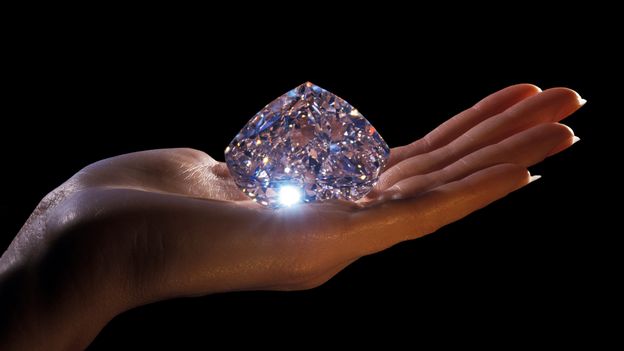
Once it had been polished and cleaved into several more manageable stones, the largest crystal it yielded would shine like the cool glow of a star in a distant galaxy.
The Cullinan was a "Clippir" diamond – a member of a special category of the very largest and clearest examples ever found.
The Imperial State Crown contains two suspected super-deep diamonds, the Cullinan II (also known as the Second Star of Africa) and the infamous Koh-i-Noor (Credit: Alamy).But working with high-value diamonds is a tricky business – ordinarily, it's impossible for researchers to get their hands on the largest specimens.
"If you want to see something rare and unusual, this is the perfect place to go because there are diamonds coming through here all the time," says Smith.
Together with an international team of scientists, he casually requisitioned 53 of the largest, clearest and most expensive available – including some from the same mine as the Cullinan diamond – and took them back to his laboratory to view under a microscope.
Nearly three-quarters of the Clippir diamonds contained tiny pockets, or "inclusions" of metal that had avoided rusting – not something you'd find in ordinary ones – while the remaining 15 contained a kind of garnet which only forms within the Earth's mantle, the layer above its molten core.
For his 2020 study – together with Wuyi Wang, who is vice presedent of research & development at GIA – Smith analysed the 124-carat diamond and found that it formed at the deeper end of the possible range – at least 660km (410 miles) below the Earth's surface.Some of the carbon in super-deep diamonds may be from ancient sea creatures, which were buried in oceanic plates that subsequently drifted down into the mantle (Credit: Alamy)."From a geological perspective, diamonds [in general] are really strange minerals," says Smith.And while these endeavours have led to much destruction, from wars and colonisation to the rerouting of rivers and upending of rare habitats, if it weren't for our enthusiasm for these sparkling lumps of carbon, "we would have no idea about this story [of their unusual properties], because we would never get to recover them and study them", says Smith.Every diamond that has ever been sold or worn, except those grown in the laboratory, is at least 990 million years old – formed at a time when strange, spaghetti-like lifeforms, primitive algae, were just beginning to creep onto land."It [the molten liquid] has picked up those diamonds from a variety of different locations and kind of mixed them together," says Smith.
"We started to wonder whether some diamonds might actually be formed deeper than others," says Smith.
"It's not just that they're big that sets them apart," says Smith."When you look at these big, high-quality [type II] diamonds, like the Cullinan, there turned out to be something strange about them, that makes them more likely to fall into this category that should otherwise be something very rare.
Eventually scientists discovered that some diamonds are "super-deep", and identified a handful of mines where they were most likely to be found – including the Cullinan mine in South Africa and Letseng mine in the nearby kingdom of Lesotho, where Smith's 124-carat specimen originated.Today many super-deep diamonds come from the Cullinan mine in South Africa, and Letseng mine in the neighbouring country of Lesotho (Credit: Getty Images)."We never really thought of them as something that could be gem quality – that we would ever be wearing super-deep diamonds or, you know, putting them in crowns or sceptres or anything like that," says Smith.
According to Smith, the unusual qualities of the world's largest and most valuable diamonds are all down to the way they form.But super-deep diamonds like the Cullinan are different."It's like molten iron nickel alloy with sulphur and carbon dissolved in that," says Smith.
In short, Clippir diamonds aren't just regular ones that have somehow grown to remarkable proportions – they're fundamentally different"I think the biggest thing they [super-deep diamonds] inform us about is the process of subduction – when an oceanic tectonic plate, sinks down into the Earth," says Smith"You can go to a volcano and say, 'yeah, this magma comes out of the Earth', or go to spreading centres of the oceans and see, that there's new crust forming…But it's really difficult to do the opposite and say, what's going down into the Earth?" says Smith
"So we've seen diamonds that look like they're essentially pieces of the oceanic crust that have been carried down to the lower mantle," says Smith
Other than confirming what happens to oceanic plates that end up in the interior of our planet, super-deep diamonds also tell us about the kinds of things you might find in the lower mantleThe largest diamonds in the world also tend to be exceptionally transparent (Credit: Alamy)However, the discovery of water-saturated ringwoodite suggests that it's stored lower down, in the same region where many super-deep diamonds form
Since smashing diamonds is generally frowned upon, Smith can't help longing for a less destructive – though no less radical – alternative: leaving diamonds in their rough form